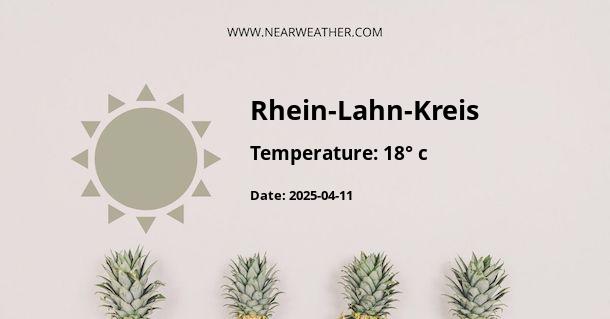Exploring the Climate and Weather of Rhein-Lahn-Kreis, Germany
The Rhein-Lahn-Kreis, located in the state of Rhineland-Palatinate, Germany, is a region characterized by its rich history, picturesque landscapes, and a climate that supports a variety of outdoor activities year-round. Understanding the nuances of its climate and weather patterns is crucial for residents, visitors, and businesses alike.
Geographical Overview
Rhein-Lahn-Kreis spans across the confluence of the Rhine and Lahn rivers, with topography that varies from river valleys to rolling hills. The varied landscape influences local weather conditions, which can change from one area to another within the Kreis.
Seasonal Climate Variations
The climate in Rhein-Lahn-Kreis is classified as a temperate oceanic climate (Cfb according to the Köppen climate classification), with distinct seasonal changes, moderate summers, and relatively mild winters compared to other regions at similar latitudes.
Spring
Spring in Rhein-Lahn-Kreis witnesses a gradual increase in temperature and daylight hours. The season is characterized by:
- Temperatures that average from 5°C to 15°C (41°F to 59°F).
- Frequent rainfall with monthly averages of 40-50mm.
- Increasing plant blooming and greenery.
According to Deutscher Wetterdienst, spring months can experience significant weather changes, with cold snaps and late frosts occasionally affecting the region.
Summer
Summer brings warmer weather with extended daylight, which is ideal for tourism and outdoor activities. Features of the season include:
- Average temperatures range between 15°C and 25°C (59°F to 77°F).
- Potential for heatwaves, where temperatures can exceed 30°C (86°F).
- Possible thunderstorms, especially in July and August.
Statistics from regional weather stations indicate that the maximum average temperature in summer months is likely to surpass historical averages due to climate change.
Autumn
Autumn sees a dip in temperatures and a return of increased precipitation. It is characterized by:
- Decreasing temperatures from 10°C to 15°C (50°F to 59°F) in early autumn to 3°C to 9°C (37°F to 48°F) by late November.
- Leaves changing color and falling, transforming the landscapes into a palette of vibrant hues.
- Rainfall averaging around 50-60mm per month.
The Rhein-Lahn-Kreis is largely sheltered by surrounding highlands, which can moderate the autumnal weather, making it less severe than in more exposed regions.
Winter
Winter in Rhein-Lahn-Kreis brings colder temperatures but less extreme conditions than in many other parts of Germany. The season's hallmarks include:
- Temperatures frequently hover around 0°C to 4°C (32°F to 39°F).
- Snowfall occurs, but significant accumulations are more common in the higher elevations.
- Days are shorter and often overcast, with fog common in the river valleys.
Data suggests that winters are gradually becoming milder, with fewer days of frost and snow as a result of gradual climate change trends.
Monthly Weather Averages
| Month | Average High (°C) | Average Low (°C) | Precipitation (mm) |
|---|---|---|---|
| January | 4 | -1 | 40 |
| February | 5 | -1 | 35 |
| March | 9 | 1 | 45 |
| April | 14 | 4 | 45 |
| May | 18 | 8 | 55 |
| June | 21 | 11 | 65 |
| July | 24 | 13 | 70 |
| August | 23 | 13 | 60 |
| September | 19 | 10 | 55 |
| October | 14 | 6 | 50 |
| November | 8 | 2 | 50 |
| December | 5 | 0 | 45 |
Weather Extremes and Records
The Rhein-Lahn-Kreis, like many regions, is not immune to weather extremes:
- The highest recorded temperature in recent years reached nearly 40°C (104°F), indicative of the more intense heatwaves occurring across Europe.
- Conversely, winter extremes have seen temperatures plummet to -15°C (5°F), particularly in the hilly areas farther from the river's moderating influence.
- Rainfall can be heavy in certain months, potentially leading to flooding, especially in areas close to the rivers.
Impact of Climate Change
Climate change is impacting the Rhein-Lahn-Kreis in various ways:
- Temperature averages show an upward trend, resulting in warmer winters and hotter summers.
- Changes in precipitation patterns, with more intense rainfall events and potential for increased flooding.
- Variation in the growth season of local crops, affecting agriculture and viticulture which are important to the regional economy.
Research indicates that the Rhein-Lahn-Kreis will continue to experience shifts in its climate, necessitating adaptation strategies for agriculture, tourism, and infrastructure development.
Weather Forecasting and Preparedness
For those living in or visiting the Rhein-Lahn-Kreis, staying informed about current weather conditions and forecasts is essential. Local meteorological services offer detailed, up-to-date weather data, and there are emergency plans in place for extreme weather events. Whether for planning daily activities, agricultural decisions, or emergency management, accurate weather information is a critical resource.
Ultimately, the climate and weather of Rhein-Lahn-Kreis offer a mild and pleasant environment for its inhabitants. With distinct seasons each holding their own charm, the region remains a captivating blend of natural beauty and cultural heritage, even in the face of a changing climate.
A - Rhein-Lahn-Kreis's Latitude is 50.268890 & Longitude is 7.865830.
A - Weather in Rhein-Lahn-Kreis is 18° today.
A - Climate Conditions in Rhein-Lahn-Kreis shows broken clouds today.
A - Humidity in Rhein-Lahn-Kreis is 44% today.
A - Wind speed in Rhein-Lahn-Kreis is 10.22 km/h, flowing at 333° wind direction. today.
